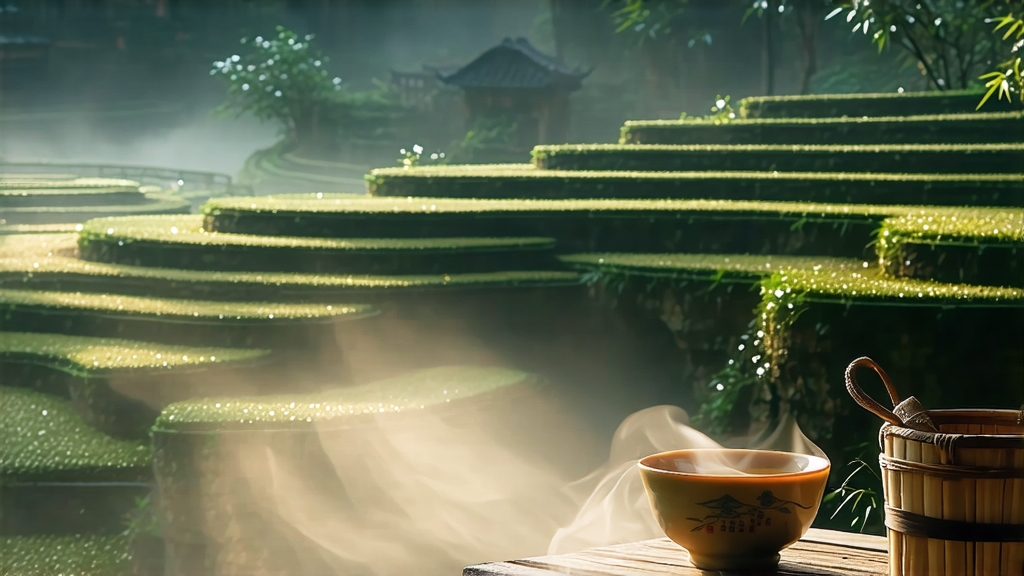
Meng Ding Huang Ya, literally “Yellow Buds from the Summit of Meng,” is the least exported yet most aristocratic member of China’s yellow-tea family. For thirteen centuries it was plucked only for emperors, carried by fast horses down the Min River gorge to Chang’an, arriving while the dew still glittered on the tiny golden tips. Foreign tea lovers who encounter it today often mistake the dry leaf for a high-grade white tea, but one sip reveals a flavor that cannot be duplicated: orchid nectar, toasted pumpkin seed, and a cooling rock-mineral finish that echoes the misty granite peaks of Sichuan’s Mt. Meng.
History begins in the Tang dynasty (618-907) when the monk Wu Li-zhen planted seven tea bushes on the summit of Meng Shan, believing the altitude—1 450 m above sea level and perpetually wrapped in cloud—would force the leaf to concentrate amino acids. When the buds were presented to Emperor Li Shimin, the court declared the tea “the Elixir of Sweet Dew,” and annual tribute was enforced until the fall of the Qing in 1911. During the twentieth century the skill of making yellow tea almost vanished; only a handful of families on the mountain kept the “men huang” (sealed yellowing) technique alive in their kitchens. In 1959 the Chinese government listed Meng Ding Huang Ya as a National Intangible Cultural Heritage, and small-batch production resumed using the original seven mother bushes, now protected behind a low stone wall inscribed with Tang poetry.
The tea belongs botanically to a local cultivar called “Meng Ding Xiao Ye Zhong” (small-leaf species). Its growing season is short: picking starts in mid-March when only the unopened bud plus the first unfolding leaf qualify. One kilogram of finished tea needs roughly 84 000 such shoots, all plucked before seven in the morning so that the leaf remains turgid with overnight moisture. Unlike green-tea pluckers who wear cotton gloves, Meng Ding pickers use bare fingers; the slight skin warmth is said to awaken the enzymes that will later create the yellow color.
Processing follows five rigid steps, each timed by the mountain’s own weather rather than the clock.
- Sha Qing (Kill-Green): 180 °C wok, 4 minutes, 200 g leaf per batch. The master’s palm must touch the metal every thirty seconds to confirm temperature; too hot and the bud burns, too cool and grassy notes persist.
- Re Han (Hot Wrap): the scalding leaf is immediately piled in a bamboo tray lined with hemp cloth, then slid into a reed basket. The basket is covered with another cloth weighted by a river stone. For the next 40 minutes the leaf suffocates in its own residual heat, initiating non-enzymatic browning that tints the edge of the bud a primrose yellow.
- San Re (Heat Release): the basket is opened, and the leaf is fanned by hand for 90 seconds to drop temperature to 35 °C. This step prevents sourness and is unique to yellow teas; green teas skip it entirely.
- San Huang (Three Yellowings): the leaf undergoes three cycles of 50-minute steaming inside a pine-wood steamer followed by 20-minute airing under shade. Each cycle deepens the golden hue and converts catechins into theaflavins, creating the signature round mouthfeel.
- Hong Bei (Low Bake): finally the buds are dried at 60 °C for two hours on a bamboo sieve set above a charcoal brazade fueled with longan wood. The fruit wood contributes a subtle honey note that lingers in the aftertaste.
The finished leaf is slim and slightly curved, the color of antique parchment shot through with downy silver tips. When broken in half it reveals a chestnut cross-section, evidence that moisture once migrated outward during yellowing. Aroma from the dry leaf is faint—only when warmed by a porcelain gaiwan does it release scents of rain-soaked granite, magnolia, and fresh soy milk.
To brew, use a 120 ml gaiwan and 3 g of leaf (about two heaping teaspoons). Water should be spring water at 85 °C; harder water dulls the orchid note. Rinse once, discard immediately. First infusion 30 seconds, second 20, third 35, then add five seconds for each subsequent pour. The liquor emerges the color of chardonnay held